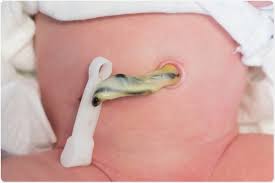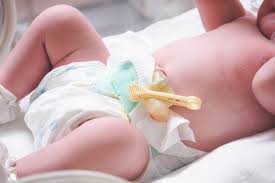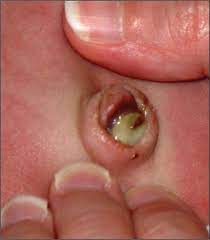Umbilical Cord Care: Keeping Your Baby’s Belly Button Healthy
Umbilical cord care is an important part of a newborn baby’s care, as it helps to ensure the baby’s health and safety. It is important to keep the umbilical cord area clean and dry and to avoid any unnecessary manipulation. In addition, the umbilical cord should be monitored regularly for any signs of infection. Please keep reading for details on the following topics:
The umbilical cord
Care of the umbilical cord
When to seek urgent medical care

THE UMBILICAL CORD
This is a vital structure during pregnancy, connecting the developing fetus to the placenta, which is attached to the uterine wall of the mother. It serves as the baby’s lifeline, providing a pathway for essential nutrients, oxygen, and blood circulation between the baby and the placenta.
Physically, the umbilical cord is a flexible, tube-like structure containing one vein and two arteries encased in a gelatinous substance called Wharton’s jelly. The vein carries oxygen-rich blood and nutrients from the placenta to the baby, while the arteries carry deoxygenated blood and waste products back to the placenta.
After birth, the umbilical cord is typically clamped and cut, severing the physical connection between the baby and the placenta. The remaining portion attached to the baby’s abdomen is called the umbilical cord stump.
Over the next week or two, the stump gradually dries out, shrinks, and eventually falls off, leaving behind the baby’s belly button or umbilicus. The cord changes from a damp white shiny appearance to dry gray, brown and black, before falling off. Once the stump has fallen off, the baby’s umbilicus requires proper care until it fully heals.
CARE OF THE UMBILICAL CORD

Care of the umbilical cord is crucial to ensure proper healing and prevent infection in newborn babies. Here are some key steps to care for the stump:
-
Keep the area clean and dry: Gently clean around the base of the cord stump with plain water or with a solution of surgical spirit (also known as rubbing alcohol) and allowed to air dry, or as recommended by your healthcare provider during diaper changes. Pat the area dry with a clean, soft cloth or sterile gauze.
- Fold the diaper: Fold the top of the diaper below the umbilical cord stump to allow air circulation and prevent the stump from getting soaked with urine or stool. This helps promote drying and prevents irritation.
- Avoid submerging the stump: While sponge bathing your baby, avoid submerging the umbilical cord stump in water until it falls off. Instead, gently wipe around the stump with a damp cloth or sponge.
- Leave the stump uncovered: Allow the stump to air dry and keep it exposed to air as much as possible. Avoid covering it with tight clothing or diapers to prevent moisture buildup.
- Watch for signs of infection: Monitor the for any signs of infection, such as redness, swelling, discharge, or foul odor. If you notice any concerning symptoms, contact your healthcare provider immediately.
- Be gentle: Handle your baby’s umbilical cord stump with care and avoid pulling or tugging on it, as this can cause pain and delay healing.
-
Follow healthcare provider’s instructions: Follow any specific instructions provided by your healthcare provider for umbilical cord care, including when to clean the stump, how often to check for signs of infection, and when to seek medical attention.
HOW TO CLEAN THE UMBILICAL CORD
-
Wash your hands thoroughly with soap and water to prevent the spread of germs.
- Gather the necessary materials, including cotton swabs or gauze pads, a clean container for holding the cleaning solution, and either sterile water or a solution of surgical spirit (rubbing alcohol) diluted with an equal amount of water.
- Lay your baby on a flat, comfortable surface, such as a changing table or bed.
- If your baby’s diaper is soiled, change it before cleaning the umbilical cord stump.
- Dip a cotton swab or gauze pad into the cleaning solution until it is damp but not dripping.
- Gently wipe around the base of the umbilical cord stump, starting from the area closest to your baby’s abdomen and moving outward. Use a new cotton swab or gauze pad for each wipe to prevent contamination.
- Continue wiping until the area is clean, removing any dirt or debris.
- Allow the umbilical cord stump to air dry completely before covering it with clothing or a diaper. Avoid using towels or tissues to dry the stump, as they may leave behind fibers that can irritate the skin.
- If you notice any bleeding or discharge from the umbilical cord stump during cleaning, gently press a clean, dry cotton swab against the area to help stop the bleeding or absorb the discharge.
-
Repeat the cleaning process 2-3 times per day or as recommended by your healthcare provider until the umbilical cord stump falls off, which typically occurs within 1-2 weeks after birth.
WHEN TO SEEK URGENT MEDICAL CARE FOR BABY
It is important to know when to seek urgent medical care, as delaying appropriate treatment can lead to further health complications. Here are some signs that indicate you should seek immediate medical attention: If your baby experiences any of the following symptoms, you should seek medical help immediately. If you have any doubts about whether you should seek medical care, it is always better to err on the side of caution and consult with your doctor.

-
Offensive purulent discharge around the base of the cord: If you notice any foul-smelling discharge or pus coming from the umbilical cord stump, it could indicate an infection that needs prompt medical evaluation and treatment.
- Redness and tenderness to the skin around the cord: If the skin surrounding the umbilical cord stump becomes red, swollen, or tender to the touch, it may be a sign of infection or inflammation requiring medical assessment.
- Pain to the area around the cord, evident by baby crying when touched: If your baby displays signs of discomfort or pain when you touch or manipulate the umbilical cord stump, it’s important to have it examined by a healthcare professional.
- Fever: If your baby develops a fever (a rectal temperature of 100.4°F or higher), it could indicate an infection, which requires immediate medical attention.
-
Bulging tissue around the navel: If you notice any bulging or protrusion of tissue around the umbilical area, it could be a sign of an umbilical hernia, which needs to be evaluated by a healthcare provider.
Disclaimer: The information provided in this content is for general informational purposes only. It is not intended as medical or healthcare advice, diagnosis, or treatment. Always seek the advice of a qualified healthcare professional with any questions you may have regarding a medical condition or healthcare decisions.

